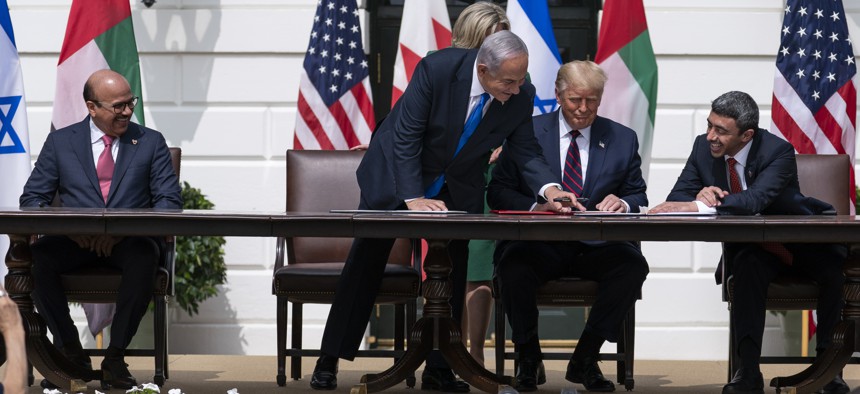
Bahrain Foreign Min. Khalid bin Ahmed Al Khalifa, left, Israeli Prime Minister Benjamin Netanyahu, President Donald Trump, and UAE Foreign Min. Abdullah bin Zayed al-Nahyan at the Abraham Accords signing, the White House, Tuesday, Sept. 15, 2020. AP Photo/Alex Brandon
Stumbling Out of the Middle East is No Better Than Stumbling In
It is tempting for the United States to just throw in the towel, pull troops, and abandon allies. More important is understanding what the U.S. strategy toward the Middle East should be.
Twenty years into a global war on terror that largely has been fought in the Middle East, it is no wonder that many Americans are long past ready to declare victory and move on. Strategists used to describe counterterrorism as “the long war”; now they are more apt to describe it as an endless one, draining resources and degrading military readiness for no lasting benefit. President Donald Trump long has seen the Middle East as a morass. As recently as last month, he lamented that “the decision to go to the Middle East and get into the Middle East was the single biggest mistake made in the history of our country.”
A debate has begun over the optimal U.S. force structure in the Middle East to secure enduring U.S. interests. Yet, in many ways, the force structure is a secondary concern. Even more important is understanding what the U.S. strategy toward the Middle East should be. How U.S. partners and adversaries understand U.S. intentions will shape their actions, because one thing is clear: When the U.S. changes its approach to the Middle East, friends and enemies, inside and outside the region, will change the way they act toward the region, to the United States, and toward each other.
The current U.S. approach to the Middle East was borne out of a different time. Originating in a Cold War struggle for oil, it morphed into a role as a global guardian of energy security, and more recently to pioneering a global war on terror. None make much sense to most Americans now. The Cold War ended 30 years ago, and the United States became a net exporter of petroleum products in 2011. Scarring though the 9/11 attacks remain, they did not usher in an age of mass casualty attacks, in part because of massive deployments of American war power into the region. Perhaps even more telling, none of the problems that the United States set out to solve decades ago in the Middle East have been solved. Iran remains a proliferation threat, Iraq remains shattered, violent extremism lingers, and Palestinians and Israelis are no closer to peace despite several high-profile U.S. efforts. It is tempting for the United States to just throw in the towel.
Yet, consider how countries would respond if they were convinced the United States was simply picking up stakes. The so-called “Abraham Accords” signed at the White House on Tuesday are part of the Gulf effort to draw the United States closer, partly through diplomacy and partly through arms purchases. But if the United States drifts away after the dust settles, peace will not follow. Current U.S. regional partners would boost their efforts to reshape the regional order in their own image, boosting like-minded allies and militias in regional states. Iran would delight in a U.S. retreat, pointing to it as a rare victory in a long-running confrontation. Sensing an opportunity, it would seek to bolster Iranian-aligned forces in Lebanon, Yemen, and elsewhere. Wealthy Gulf states would feel a threat and feel compelled to boost their own spending on Iran’s adversaries. We should expect proxy wars in Yemen and Libya, and perhaps Iraq and Syria, to increase beyond their current contours, enlarging the number of radicalized and trained fighters in the region and creating volatility in global oil markets.
Regional countries would surely seek to court outside powers, and especially Russia and China, to take over some of the abandoned U.S. security role.
Both will be careful not to replicate what they see as U.S. mistakes. Russia would be more circumspect, seeking to establish client states from which it would extract short-term commercial benefit. China will seek broader ties, in part to tie down short-term access to energy, and in part to build trade infrastructure to reach to Europe. While China advertises its interest in “win-win” solutions that have no military components, China will seek to embed infrastructure in the region that provides durable intelligence gathering capabilities, including commercial espionage.
Politically and socially, the two countries will seek to bolster authoritarian systems that brook no compromise. Some might argue the approach will be a salutary one that will permanently bury political Islam and extremism. But another view, often embraced by past U.S. administrations, is that authoritarianism itself breeds extremism.
U.S. allies, and those in Asia especially, would see unchecked Chinese influence in the Middle East as a threat to their security. Japan and South Korea are almost entirely dependent on imported energy, and the overwhelming majority of that comes from the Middle East. Relying on China rather than the United States for their energy security will force them to draw closer to China.
In the longer term, as fossil fuels become more marginal to global economic output, the economies of the Middle East face a need to diversify. We should expect neither Russia nor China to do much to help that process. As a result, the Middle East could become a regional population of 400 million people — more by 2050 — with diminishing economic prospects, diminishing governmental capacity, and rising anger. The region’s problems may be contained, but it is more likely to expand outward, with violence and refugee flows. Neither the United States or its allies would be immune.
The United States’ efforts to guide the region for the last four decades have been mixed at best. Despite decades of U.S. effort, the region remains authoritarian, relatively divided, and tied to hydrocarbons. Arguably, though, it is less of all of those things because of U.S. and allied efforts.
For the United States, the answer is to advance its broad interests in the region beyond the military links that have driven much of U.S. engagement for decades. That means enhancing economic and educational ties to draw the region closer to the United States. It means boosting efforts to promote local, bottom-up solutions to national challenges, and increasing partners’ receptivity to those solutions. It means engaging in meaningful and sustained diplomatic efforts to diminish tensions and increase regional cooperation and regional integration. It means developing stronger partners who can advance common interests. Ultimately, as well, it will mean making clearer choices about what it cares about in the region. The United States should not remain committed to being the dominant foreign partner of every country in the region. At the same time, it needs to identify key sectors in key states where it will brook no challenge.
U.S. strategy toward the Middle East is out of step not only because it tries to do too much with military instruments, but also because it tries to do it in too many places. An abrupt military withdrawal will cause partners around the world to recoil and adversaries to pounce.
The Middle East will strongly influence U.S. security for years to come. Abandoning allies to the depredations of adversaries will not change that, but it would make it much worse.
